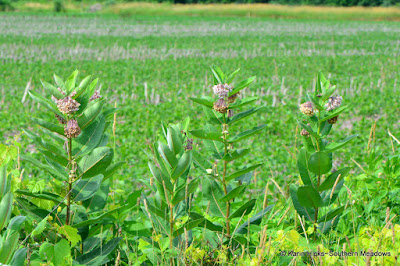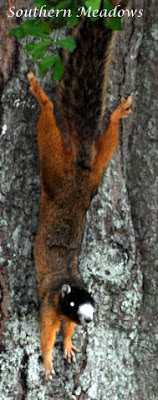Travels this summer took me to Michigan and Minnesota. I always know I've arrived in the Midwest when I begin seeing common milkweed (
Asclepias syriaca) all along the roadside. Once upon a time it grew humbly everywhere, but in many agricultural areas it has mostly vanished from the landscape. I have yet to find it growing plentifully in North Georgia. Several times I've attempted to grow it in our home garden with limited success.
 |
| Common milkweed growing along side a soybean field |
But in my sister's Michigan garden it grows abundantly. Here it finds a home between rocks, at the edge of the farmer's field who resides in the adjacent property, along the walking paths and in the pastures and meadows. This is a very good thing because areas along the Monarchs' migration route are in dire need of more milkweed. It is interesting to note that common milkweed is one of the few native prairie plants that can survive the annual disturbances that occurs when farmer's prepare their corn and soybean fields.
 |
| Gorgeous common milkweed standing tall |
Monarchs are certainly the most recognized guest on milkweed, but there are many other insects that rely sole on milkweed plants for survival. The red milkweed beetle is a member of the long horned beetle family and is host specific to common milkweed, where its grubs feed on the
roots and stem of the milkweed plant and overwinter in the stems while the
adults feed on the foliage and flowers.
 |
| red milkweed beetles on milkweed |
Monarch butterflies are not the only butterfly to enjoy the sweet nectar from these fragrant blooms. Many other species of butterflies are found visiting the blooms that often drupe under their own weight.
 |
| Swallowtail and red milkweed beetle on common milkweed |
It is also popular with both long and short-tongued beetles, wasps, flies, and moths. My sister and BIL have an amazing apiary and many of the honey bees happily visit the aromatic blooms during the summer months.
 |
| honey bees on milkweed blooms |
 |
| bumble bee on common milkweed flowers |
Ants were scrambling around several plants which were teeming with aphids. These honey ants and aphids have a mutual relationship were the ants protect the aphids from predators in exchange for feeding on the sugary honeydew the aphids secrete.
When this milkweed is not in bloom it fades into the greenery that litters the Michigan roadsides still providing food for the monarch larva and milkweed beetle. But, it makes me wonder why Midwestern states have more success growing common milkweed than the Southeastern states. Maybe they are blessed with more loamy soil, which this milkweed species prefers, or perhaps they are more mindful about spraying herbicides and implementing appropriate mowing schedules. All steps that help conserve native vegetation and the insects they support.









.png)
